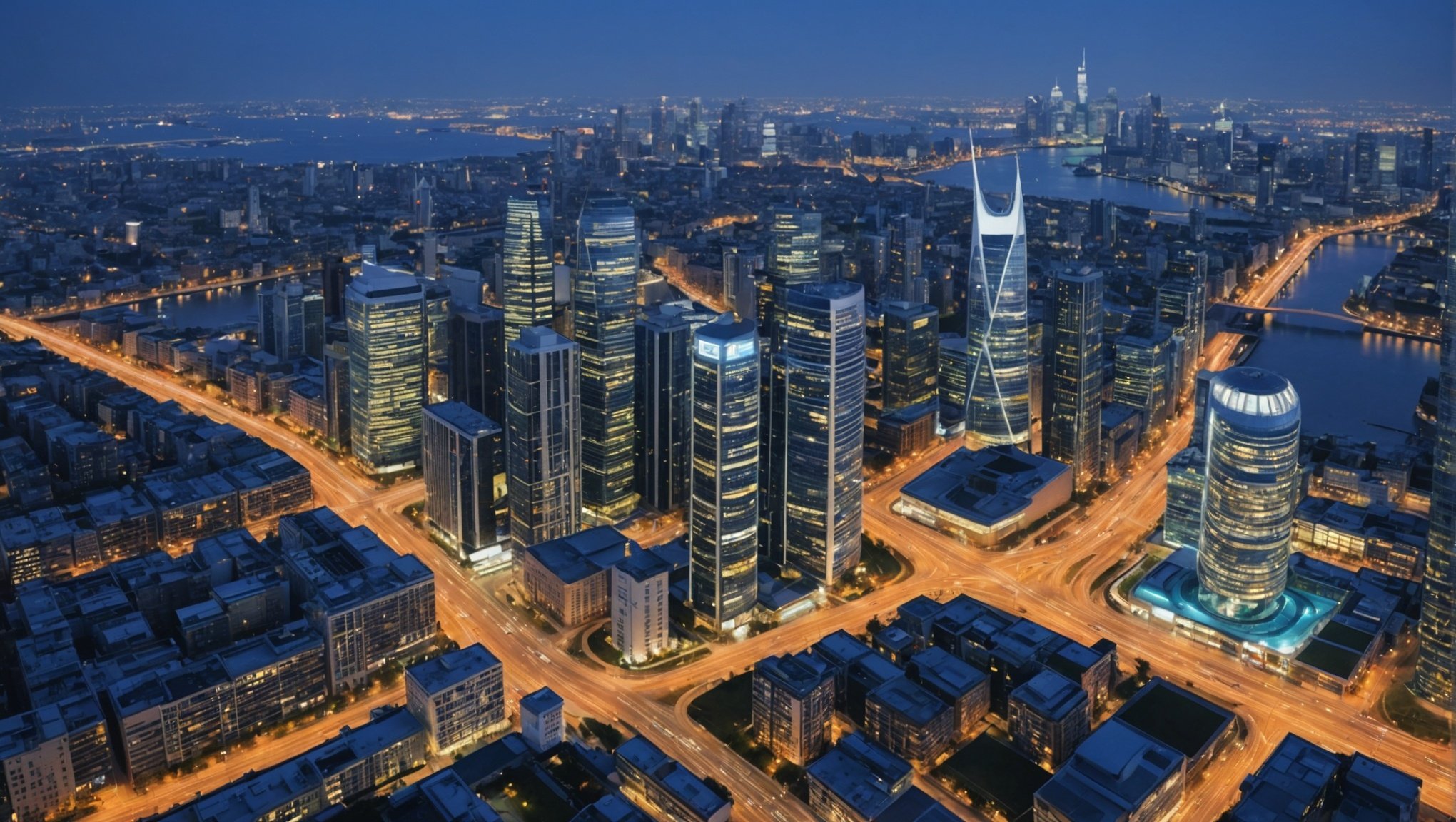Unlocking the Future: AI-Driven Strategies for Enhancing Renewable Energy Management in Smart Cities
As the world grapples with the challenges of climate change, energy sustainability, and urbanization, the integration of artificial intelligence (AI) in renewable energy management is emerging as a pivotal solution. Smart cities, with their advanced infrastructure and technological prowess, are at the forefront of this revolution. Here, we delve into how AI-driven strategies are transforming the energy sector, making cities more sustainable, efficient, and resilient.
The Role of AI in Renewable Energy Management
AI is not just a tool; it is a game-changer in the energy sector. By analyzing vast amounts of data in real time, AI can optimize energy consumption, predict energy demand, and manage energy distribution more efficiently.
Additional reading : Revolutionizing Real Estate Investment: The Impact of AI-Driven Tools on Analysis
Real-Time Data Analysis and Forecasting
AI algorithms can process real-time data from various sources such as weather forecasts, energy consumption patterns, and market prices. This data is crucial for managing renewable energy sources like solar and wind power, which are highly dependent on weather conditions. For instance, Microsoft researchers have developed AI models that use reinforcement learning to control grid and battery processes, enabling microgrids to adapt to changing energy conditions and market dynamics.
Optimizing Energy Distribution
AI can optimize energy distribution by predicting peak loads and managing energy storage. For example, AI-driven microgrids can autonomously buy and sell energy based on strategic design parameters, maximizing efficiency and maintaining local power availability. This approach has been successfully tested in simulations using real data from the California Independent System Operator (CAISO), demonstrating the potential of AI-driven microgrids under real-world conditions.
Also to see : Unlocking Enhanced Earth Observation: The Transformative Power of Synthetic Aperture Radar (SAR)
Smart Grids and Energy Efficiency
Smart grids are the backbone of modern energy management in smart cities. These grids integrate AI-equipped sensors and edge servers to optimize energy output, distribution, and storage.
Key Technologies in Smart Grids
-
Flywheel Energy Storage Systems (FESS) and Battery Energy Storage Systems (BESS): These technologies act as instant and long-term energy buffers, respectively, helping to manage fluctuations and prevent congestion in the grid. FESS quickly absorbs and releases energy, while BESS stores surplus electricity during low-demand periods and releases it when demand surges.
-
AI-Enhanced Edge Computing: This technology enables real-time data processing at the edge of the network, reducing latency and improving the efficiency of energy management. For example, AI-equipped sensors in smart grids can optimize energy distribution and avoid outages by predicting energy demand and adjusting supply accordingly.
Case Studies: Real-World Implementations
Several real-world projects and initiatives illustrate the potential of AI-driven strategies in renewable energy management.
NEOM: Saudi Arabia’s Futuristic Smart City
NEOM, a futuristic smart city in Saudi Arabia, is a prime example of how AI and renewable energy can be integrated to create a sustainable urban environment. NEOM will be powered entirely by renewable energy sources such as solar and wind, and AI will be used to manage resources, monitor traffic, and optimize services like healthcare, education, and security. This city is part of Saudi Arabia’s broader strategy to reduce its dependence on oil and shift towards a more knowledge-based economy.
Microsoft’s AI-Powered Microgrids
Microsoft researchers are collaborating with local communities to develop AI-powered microgrids that prioritize energy availability, equity, and decarbonization. These microgrids can operate independently from the larger grid, providing participants with resilience and control. The AI model is optimized for resilience and efficiency, using reinforcement learning to control grid and battery processes. This initiative has shown promising results in simulations and real-world applications, highlighting the potential of AI-supported technologies for community-scale energy solutions.
Challenges and Opportunities in the Energy Sector
While AI-driven strategies offer numerous benefits, there are also challenges and opportunities that need to be addressed.
Energy Demand and Infrastructure
The growing demand for energy, particularly with the rise of data centers and AI models, poses significant challenges to the existing energy infrastructure. Data centers alone could require up to nine percent of total U.S. power demand by 2030, highlighting the need for a distributed, flexible energy infrastructure. This includes deploying energy generation and storage systems directly on commercial properties, transforming each into a decentralized power node.
Public Safety and Urban Planning
AI can also enhance public safety and urban planning by optimizing energy systems to prevent outages and ensure reliable energy supply. For instance, AI-driven energy management systems can adjust machine operating schedules and optimize HVAC systems, reducing energy consumption and enhancing overall efficiency.
Practical Insights and Actionable Advice
For cities looking to adopt AI-driven strategies in renewable energy management, here are some practical insights and actionable advice:
Invest in Distributed Energy Infrastructure
- Decentralized Power Nodes: Deploy energy generation and storage systems directly on commercial properties to create decentralized power nodes. This approach can help balance grid demands in real-time and alleviate congestion.
Leverage Advanced Technologies
- AI-Enhanced Edge Computing: Implement AI-equipped sensors and edge servers to optimize energy output, distribution, and storage. This can save energy and avoid outages by predicting energy demand and adjusting supply accordingly.
Collaborate with Local Communities
- Community-Scale Energy Solutions: Collaborate with local communities to develop AI-powered microgrids that prioritize energy availability, equity, and decarbonization. This can provide participants with resilience and control over their energy systems.: A Future Fueled by Innovation
The integration of AI in renewable energy management is not just a trend; it is a necessity for creating sustainable and resilient smart cities. As we move forward, it is clear that AI will play a critical role in optimizing energy systems, managing energy distribution, and ensuring public safety.
Key Takeaways
- AI-Driven Energy Management: AI can optimize energy consumption, predict energy demand, and manage energy distribution more efficiently.
- Smart Grids: AI-equipped sensors and edge servers can optimize energy output, distribution, and storage.
- Distributed Energy Infrastructure: Decentralized power nodes can help balance grid demands in real-time and alleviate congestion.
- Community Collaboration: Collaborating with local communities can provide resilient and equitable energy solutions.
As Erica Holloman-Hill, director of WAWA and CEO of Ayika Solutions, noted, “Partnerships like this one, controlling and sharing the electricity the community generates, is within reach, highlighting the potential of AI-supported technologies like microgrids for communities like ours.”
In conclusion, the future of renewable energy management in smart cities is indeed bright, and it is fueled by the innovative application of AI. As we continue to navigate the challenges of urbanization and sustainability, embracing these technologies will be crucial for creating a more sustainable, efficient, and resilient urban environment.
Detailed Bullet Point List: Key Benefits of AI-Driven Renewable Energy Management
- Optimized Energy Consumption: AI can analyze consumption patterns and optimize energy use in real-time.
- Predictive Maintenance: AI can predict equipment failures and schedule maintenance, reducing downtime.
- Enhanced Efficiency: AI can optimize HVAC systems, adjust machine operating schedules, and integrate renewable energy sources.
- Real-Time Forecasting: AI can predict energy demand and adjust supply accordingly, preventing outages.
- Decentralized Energy Solutions: AI-powered microgrids can operate independently from the larger grid, providing resilience and control.
- Public Safety: AI can enhance public safety by optimizing energy systems to prevent outages and ensure reliable energy supply.
- Sustainable Energy: AI can help transition to 100% renewable energy sources, reducing carbon emissions and promoting sustainable living.
- Community Empowerment: AI can enable community-scale energy solutions that prioritize energy availability, equity, and decarbonization.
Comprehensive Table: Comparison of Traditional and AI-Driven Energy Management Systems
| Feature | Traditional Energy Management | AI-Driven Energy Management |
|---|---|---|
| Energy Consumption Analysis | Manual analysis of historical data | Real-time analysis of consumption patterns |
| Predictive Maintenance | Scheduled maintenance based on fixed intervals | Predictive maintenance based on AI-driven insights |
| Energy Distribution | Manual adjustment of energy supply | Automated adjustment of energy supply based on real-time data |
| Renewable Energy Integration | Limited integration of renewable sources | Optimal integration of renewable sources using AI-driven analytics |
| Public Safety | Reactive measures to address outages | Proactive measures to prevent outages using AI-driven insights |
| Community Involvement | Limited community involvement | Community-scale energy solutions prioritizing energy availability, equity, and decarbonization |
| Energy Efficiency | Limited optimization of energy systems | Enhanced efficiency through AI-driven optimization of HVAC systems and machine operating schedules |
| Scalability | Limited scalability due to centralized infrastructure | Scalable and decentralized energy infrastructure using AI-driven management |
By embracing AI-driven strategies, smart cities can unlock a future that is not only sustainable but also efficient, resilient, and equitable. The journey ahead is promising, and with the right technologies and collaborations, we can create urban environments that thrive on innovation and sustainability.













